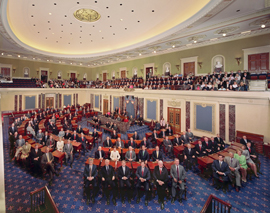
It wasn’t until the mid 1850s that the term “filibuster” started being used, derived from the Dutch word for freebooter and the Spanish word “filibusteros”—to describe the pirates then raiding Caribbean islands, which gives you an idea of what was thought of it.
We elect Senators to go to Washington to conduct the business of thoughtful legislation that represents our (their constituents) interests. The filibuster prevents the work of the Senate from taking place. Today, when there are so many issues at stake, the filibuster is outdated, obsolete, and a throw-back to a less complicated time. There is nothing in the Constitution or the rules of the Senate giving the filibuster a place in the techniques used by our Senators to get their work done; in fact, it accomplishes the opposite! There is no such “technique” in the House of Representatives. The filibuster is based on the idea that one person or group can block a particular piece of legislation they don’t agree with and stop the work of the Senate from continuing. Now, Senators don’t even have to talk nonstop, they can just threaten a filibuster. How is this democratic? How does it even make any logical sense?
“In 1917, with frustration mounting and at the urging of President Woodrow Wilson, senators adopted a rule (Senate Rule 22) that allowed the Senate to invoke cloture and limit debate with a two-thirds majority vote….Even with the new cloture rule, however, filibusters remained an effective means to block legislation, since a two-thirds vote was difficult to obtain. Over the next four decades, the Senate managed to invoke cloture only five times. Filibusters proved to be particularly useful to southern senators who sought to block civil rights legislation, including anti-lynching bills. Not until 1964 did the Senate successfully overcome a filibuster to pass a major civil rights bill. [This was the most consistent and frequent use of the filibuster in Senate history. My notation from evidence in the historical record.] Nevertheless, a growing group of senators continued to be frustrated with the filibuster and pushed to change the cloture threshold. In 1975, the Senate reduced the number of votes required for cloture from two-thirds of senators voting to three-fifths of all senators duly chosen and sworn, or 60 of the current 100 senators.” [Emphasis mine.] https://www.senate.gov/about/powers-procedures/filibusters-cloture/overview.htm
PLEASE contact your Senators, ‘educate’ them on the filibuster, and encourage them to support getting rid of this antique holdover of flourishing oratory.

US Senate from US Senate Archives

Leave a Reply